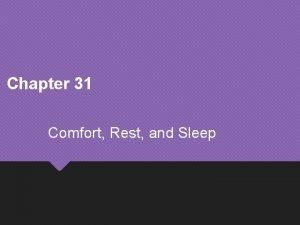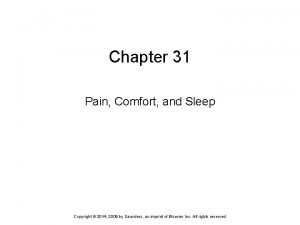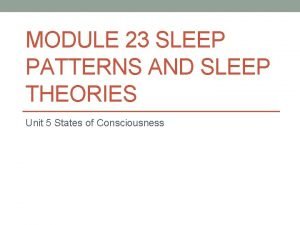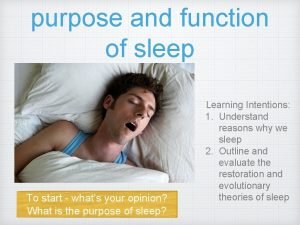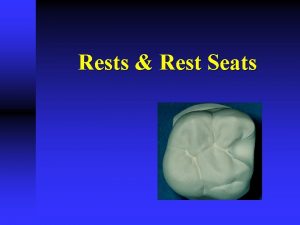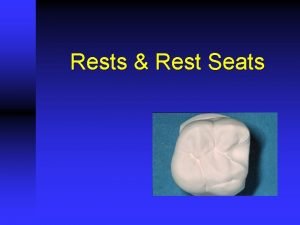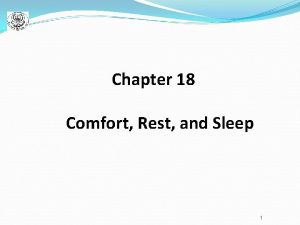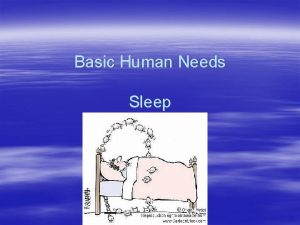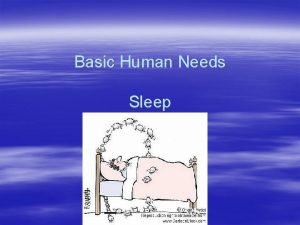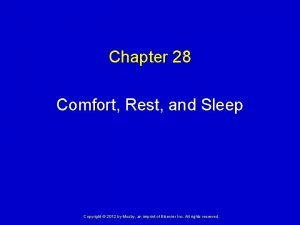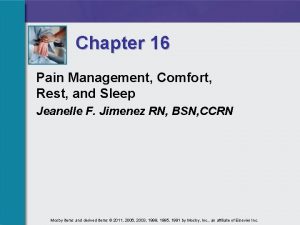Chapter 18 Comfort Rest and Sleep 1 Comfort











- Slides: 11

Chapter 18 Comfort, Rest, and Sleep 1

Comfort, Rest, and Sleep Comfort : ( state is which a person is relieved of distress ) that facilitates rest and sleep Rest : (waking state characterized by reduced activity and mental stimulation) Sleep: (state of arousable unconsciousness) Safe, clean, and attractive environment contributes to comfort. Environment : refers to room where the client receives nursing care and its furnishing LIGHTING—adequate lighting, both natural and artificial is important to the comfort of clients and nursing personnel. 2

The Client Environment: client’s room & furnishings Client rooms Wall: relaxing color schemes, wallpapers Floor: carpeted or linoleum ( )ﺟﻠﺪﻱ surface Lighting: adequate lighting, both natural and artificial is important to the comfort of clients and nursing personnel. Climate control: 1. Temperature : most clients are comfortable if temp is 20 -23˚C 2. Humidity: Amount of moisture in the air (30 -60% comfortable). 3. Ventilation: Movement of air 3

The Client Environment (cont’d) • Room furnishings – – Bed o Mattress o Pillows o Linen Privacy curtain – Overbed table – Bedside stand – Chairs 4

Sleep and Rest Functions of sleep 1. Reduces fatigue 2. Stabilizes mood 3. Improves blood flow to brain 4. Enhances various physiologic processes (Increasing protein synthesis. ) 5. Improves immune system 6. Promotes emotional well-being 7. Improves capacity for learning and memory storage 5

Sleep and Rest (cont’d) 1. Sleep phases 2. Non rapid eye movement (NREM) Quiet sleep ( )ﻧﻮﻡ ﺧﻔﻴﻒ o Precedes REM 3. Rapid eye movement (REM) o Active or deepest stage of sleep ( )ﻧﻮﻡ ﻋﻤﻴﻖ o Most dreams occur o 6

Sleep and Rest (cont’d) Effect of chronic sleep deprivation 1. 2. 3. 4. 5. 6. 7. 8. 9. Altered comfort. Impaired coordination. Loss of muscle mass and weight. Increased susceptibility to infection. Slower wound healing. Decreased pain tolerance. Poor circulation. Unstable moods. Impaired judgment. 7

Sleep and Rest (cont’d) Sleep cycles Alternate through NREM and REM phases 4 -6 times / night Sleep requirements Vary among different age groups Decreases from birth to adulthood (table 18 -2) 8

Factors affecting sleep P 380+81 1. Old age 6. Emotions and moods 2. Light 7. Food and beverages 3. Activity 8. Illness 4. Environment 5. Motivation 9. Drugs o Sedatives and tranquilizers o Hypnotics o stimulants 9

Sleep Disorders INSOMNIA: difficulty falling asleep, awakening frequently during the night or awakening early. HYPERSOMINA: characterized by feeling sleepy despite getting normal sleep. SLEEP APNEA: cessation of breathing. HYPOPNEA: hypoventilation PARASOMNIA: conditions associated with activities that cause arousal or partial arousal (P 385, Column II). 10

Nursing Implications Sleep-promoting nursing measures Maintaining sleep rituals Reducing intake of stimulating chemicals Promoting daytime exercise Adhering to regular schedule for retiring and waking Progressive relaxation Back massage 11
 Chapter 31 comfort rest and sleep
Chapter 31 comfort rest and sleep Chapter 31 comfort rest and sleep
Chapter 31 comfort rest and sleep Comfort and rest
Comfort and rest Comfort and rest
Comfort and rest Module 23 sleep patterns and sleep theories
Module 23 sleep patterns and sleep theories Module 23 sleep patterns and sleep theories
Module 23 sleep patterns and sleep theories Module 23 sleep patterns and sleep theories
Module 23 sleep patterns and sleep theories Floor of occlusal rest
Floor of occlusal rest Indirect retainer in class 1
Indirect retainer in class 1 Embrasure rest seat preparation
Embrasure rest seat preparation Hand roll comfort device
Hand roll comfort device Come sleep o sleep the certain knot of peace
Come sleep o sleep the certain knot of peace
